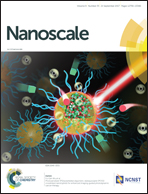Oxygen defect engineering by the current effect assisted with temperature cycling in a perovskite-type La0.7Sr0.3CoO3 film†
Abstract
Introducing and modulating the oxygen deficiency concentration have been received as an effective way to obtain high catalytic activity in perovskite oxides. However, it is difficult to control the oxygen vacancy in conventional oxygen defect engineering due to harsh reaction conditions at elevated temperatures and the reducing atmosphere, which make it impractical for many technological applications. Herein, we report a new approach to oxygen defect engineering based on the combination of the current effect and temperature cycling at low temperature. Our investigations revealed that the electrical conductivity of the (011)-La0.7Sr0.3CoO3/PMN-PT film changes continuously from metallicity to insulativity under repeated transport measurements below room temperature, which indicates the transformation of the Co4+ state to Co3+ in the film. Further experiments and analysis revealed that oxygen vacancies can be well regulated by the combined current effect and temperature cycling in repeated measurements, which results in a decrease of Co4+/Co3+ and thus the remarkable variation of conductive properties of the film. Our work provides a simple and highly efficient method to engineer oxygen vacancies in perovskite-type oxides and brings new opportunities in designing high-efficiency oxidation catalysts.



 Please wait while we load your content...
Please wait while we load your content...